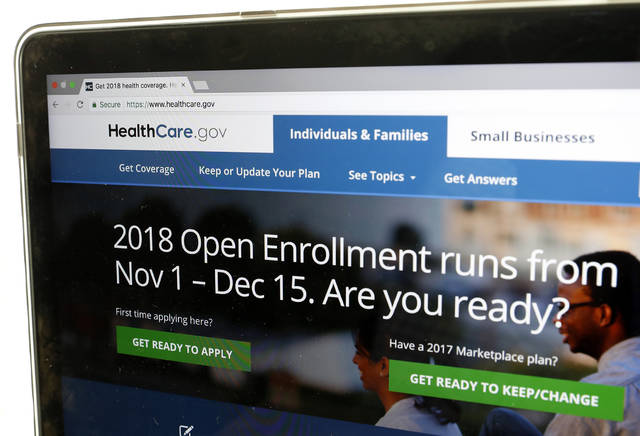WASHINGTON — Premiums for the most popular “Obamacare” plans are going up an average of 34 percent, according to a study Wednesday that confirms dire predictions about the impact of political turmoil on consumers. ADVERTISING WASHINGTON — Premiums for the
WASHINGTON — Premiums for the most popular “Obamacare” plans are going up an average of 34 percent, according to a study Wednesday that confirms dire predictions about the impact of political turmoil on consumers.
Window-shopping on HealthCare.gov went live Wednesday, so across the country consumers going online can see the consequences themselves ahead of the Nov. 1 start of sign-up season for 2018.
The consulting firm Avalere Health crunched newly released government data and found that the Trump administration’s actions are contributing to the price hikes by adding instability to the underlying problems of the health law’s marketplaces.
President Donald Trump puts the blame squarely on “Obamacare” saying the program is imploding, while ignoring warnings that his administration’s actions could make things worse.
The Avalere analysis is for the 39 states using HealthCare.gov. Along with the increase for silver plans, premiums also are going up by double digits for different levels of coverage, including bronze (18 percent), gold (16 percent), and platinum (24 percent).
Many states had higher increases. Avalere found that average plan silver premiums will go up by 49 percent in Florida, 43 percent in Missouri, and 65 percent in Wyoming.
Consumers eligible for income-based tax credits will be protected from rising premiums but those who pay full-cost face a second consecutive year of sharp premium increases.
Only three states will see declines — Alaska, Arizona, and North Dakota.
Avalere said market instability is driven by Trump’s recent decision to end subsidy payments to insurers, the continued debate over “Obamacare” repeal and replace, and a presidential executive order that could open a path for lower cost plans outside of the Obama-era law.
“You put all that together, and there are a lot of additional forces on top of market forces driving high premium increases for 2018,” said Chris Sloan, a senior manager with the health industry consulting firm.
Significant increases also are expected in states that run their own health insurance websites.
Starting Nov. 1, new customers can submit applications, and returning ones can make changes to their coverage. Open enrollment will end early, on Dec. 15, about half the time allotted under Barack Obama’s administration.
Sign-up season comes after the president abruptly pulled the plug on federal payments that reimburse insurers for reduced copays and deductibles they’re required to provide to people of modest means. That exposes insurers to a potential $1 billion loss for the remainder of this year.
A federal judge in San Francisco on Wednesday denied a request by state attorney’s general to order the payments immediately restored. Administration officials say the payments were not properly approved by Congress and Trump is following the U.S. Constitution by denying them.
Bipartisan legislation to resolve the problem is pending, and the Congressional Budget Office on Wednesday said the bill would reduce federal deficits and have no major impact on coverage. But the legislation by Sens. Lamar Alexander, R-Tenn., and Patty Murray, D-Wash. faces an uncertain future.
Trump has sent mixed signals about whether he would support it.
Restoring the funds may have little immediate impact on 2018 premiums, but the bill calls for insurers to rebate money to the government and consumers if they collect too much.
Avalere’s Sloan said that consumers who receive subsidized premiums would generally be protected from premium increases.
That’s not the case, however, for an estimated 7 million unsubsidized customers, most of whom buy individual plans outside the government markets.
“There is a danger that middle-class people who don’t get government help in paying their premiums could be increasingly priced out of the market,” said Larry Levitt of the nonpartisan Kaiser Family Foundation.
About 10 million people currently have private health insurance through government-sponsored markets like HealthCare.gov. More than 8 in 10 customers receive tax credits to help pay their premiums, and that aid is still available despite the political turmoil.
Unlike the Obama years, the Trump administration has set no enrollment goal for 2018.
“We are really focused on having a smooth consumer experience,” said Randy Pate, director of the HHS office that oversees the program. “That is our target for this year.”
Administration officials say they have made a series of improvements to the sign-up process unheeded in the acrimonious political debate over health care.
___
Online – https://www.healthcare.gov/get-coverage/



